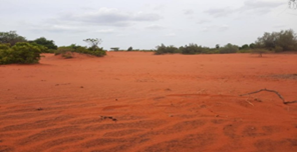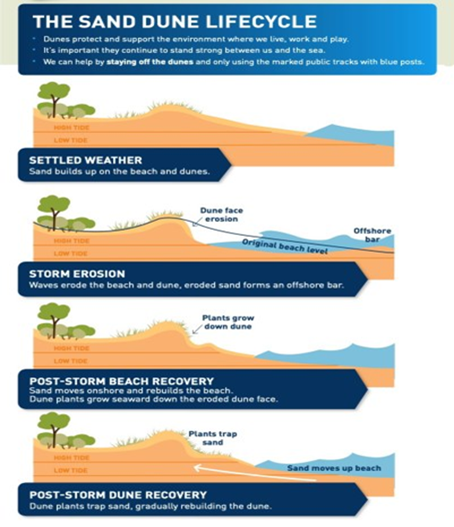

Context
A Small desert in the state of Tamil Nadu’s Thoothukudi district has been identified, that consists of red sand dunes.
- The colour of these dunes says about the regions geological history and its semi-arid climate.

About
What are dunes?
- A duneis a landform composed of wind- or water-driven sand.
- It typically takes the form of a mound, ridge, or hill and occurs in different shapes and sizes.
- Dunes are made of sand-sized particles, and may consist of quartz, calcium carbonate, snow, gypsum, or other materials.
- Dunes are most common in desert environments, where the lack of moisture hinders the growth of vegetation that would otherwise interfere with the development of dunes.
- However, sand deposits are not restricted to deserts, and dunes are also found along sea shores, along streams in semiarid climates, in areas of glacial outwash, and in other areas where poorly cemented sandstone.
About Red dunes
- The red dunes are called theriin Tamil.
- They consist of sediments dating back to the Quaternary Period and are made of marine deposits.
- They have very low water and nutrient retention capacity and are susceptible to aerodynamic lift.
- The iron-rich heavy minerals like ilmenite, magnetite, garnet, hypersthene and rutile present in the soil.
- They had undergone leaching by surface water and were then oxidised because of the favourable semi-arid climatic conditions.

Significance
- Helps in studying rocks: The lithology of the area shows that the area might have been a paleo (ancient) coast in the past.
- The presence of limestone in many places indicates marine transgression.
- Ancient Coastal evidences: The present-day therismight have been formed by the confinement of beach sand locally. These are geological formations that appeared in a period of a few hundred years.
How they are formed?
- The red sand is brought from the surface of a broad belt of red loam in the plains of the Nanguner region) by south west monsoon winds during May-September.
- The south west monsoon winds, after draining the moisture behind the Mahendragiri hill and the Aralvaimozhi gap of the Western Ghats become dry and strike the plains in the foothills, where vegetation is sparse.
- Deforestation and absence of vegetative cover in the Aralvaimozhi gap and the Nanguneri plains are considered to be the major causes of wind erosion.
- Hence the fine materials with light weight are picked up, suspended in the air and carried away.
- These processes of erosion, transport and deposit of sediments that are caused by wind at or near the surface of the earth, are called Aeolian processes.
- They lead to continual sand redistribution. The sand deposited thus also forms a further obstruction, causing more sand to be deposited and the process goes on.
Concerns
- Illegal sand mining in the region is prevalent due to high mineral and fine grained sand.


